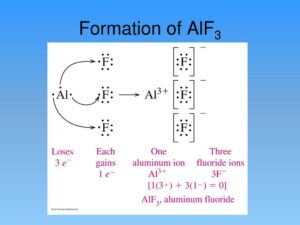The article would describe is AlF3 Ionic or Covalent by explaining the reasons behind the consideration. It would represent the atomic structure of AlF3, which has been described by Lewis (named as Lewis Dot Structure).
AlF3 has been found as an Ionic compound. Its Lewis structure and details of formation by possessing the principles of ionic bonding are quite interesting to demonstrate in inorganic chemistry.
Is AlF3 Ionic or Covalent?
AlF3 is ionic by nature. The electronic arrangement in the compound is the proof holder to make the compound ionic. Aluminium transfers its three electrons from last electronic cell to three Fluorine atoms. In this way, three Fluoride ions are noticed to be generated.
Complete donation of electron takes place instead of sharing therefore; Aluminium Fluoride is Ionic not a covalent compound. This statement holds several reasons anyway.
Why AlF3 is Ionic?
The most feasible reason for considering an compound as Ionic compound is to identify if any one element of the compound is completely transferring it electron or electrons to the other one or not.
Aluminium has been identified to donate it three electrons to fluorine atoms. This entire transfer of election is the feature, which makes is Ionic. Otherwise many ionic characteristics have been found to be followed by Aluminium Fluoride, which reliably support the statement that is “Alf3 is ionic.”
On the other hand, another supportive reason is that Aluminium is a metal, which donates its electrons to the non-metal Fluorine (smallest halogen element). In the case of forming ionic bonding, the very distinguishable elements take place as participants always.
Besides, Aluminium Fluoride appears as a crystalline solid and generally, ionic compounds appear in the same state.
The melting point of ionic compounds is noticed to be high. AlF3 has high melting point due to the sting electrostatic force between the ions. The melting point of AlF3 is 1560K.
However, ionic compounds are highly soluble in polar solvents like water. AlF3 is also water-soluble. It can be soluble in water in 0 °C as well.
These properties are very influential to describe AlF3 as an Ionic compound. The evidence would enhance the knowledge about ionic compounds as well.
Have additional overview on the properties of ionic compounds.
Why AlF3 is not covalent?
There is a strong reason, which can genuinely explain the chemistry behind not considering Aluminium fluoride as a covalent compound. n this section of article the reasons for not taking Alf3 in the list of covalent compound.
In AlF3 Aluminium completely transfers electron to Fluorine but the sharing is not possible as Aluminium is larger and fluorine is the smallest halogen in the series. They cannot make bond by similar amount of electron sharing.
Fluorine is the most electronegative element in the universe. This does not show polarization. For covalent bonding, it is needed to have two almost similar sizes of elements, which will share the electrons without any hazards.
According to the above reason, chlorine has been noticed to make covalent bond with the Aluminium and generate AlCl3. Chlorine shows polarization property, which is supportive as well.
Fajan’s rule is also reliable in supporting the facts that “AlF3 is not covalent”. According to Fajan, the decreasing size of cation and increasing size of anion is the encouraging fact for influencing the concept of making covalent bond between two atoms.
The above-explained facts are quite attainable to accept the fact that is “AlF3 is not covalent”. Besides, AlF3 does not show any kind of covalent characteristic as well.
Read more about covalent characteristic with examples.
Lewis structure of Aluminium fluoride
The Lewis structure of Aluminium Fluoride is the specific proof to show that the compound is ionic. It would be represented here to provide better knowledge on the electron transferring process that happen during the formation of AlF3.

Lewis electron dot structure shows the exact amount of electrons, which has been donated by Aluminium and how three different fluorine atoms accept the electrons. The structure describes the electron transferring facts with explanation in justified way.
In the case of filling the octet state and getting huge stability, Aluminium donates its three electrons and forms cation with 3+ charge. Fluorine seeks for one electron in tits last cell to get the similar stability as its nearer noble gas. Therefore, the three fluorine molecules adopt those three free electrons and they become fluoride (anion). This is the electronic reaction in AlF3.
However, this compound is considered as the strongest Lewis solid acid. The compound possess high Lewis acidity and act as a heterogeneous catalyst. AlF3 helps to activate the bond between carbon bad fluorine and carbon and hydrogen as well.
Frequently Asked Questions (FAQs)
Question 1: Why does AlCl3 not consist of ionic binding?
Answer: According to Fajan’s rule the increasing size of anion and decreasing size of cation shows tendency to make covalent bond. As chlorine is larger anion, it shares electron instead of adopting the electrons from aluminium. Therefore, it does not consist of Ionic bond.
Question 2: What is the strongest solid Lewis acid? Write its formula.
Answer: Aluminium fluoride is considered as the strongest Lewis acid, it is amorphous solid. Its chemical formula is AlF3.
Question 3: What is the basic reason for considering AlF3 as an Ionic compound?
Answer: Aluminium the large cation completely transfers its three electron to three individual Fluorine atom (smallest halogen or anion) and it influences them to create strong ionic bond. That is why it is considered as ionic compound.
Question 4: Explain one similar matter between AlF3 and AlCl3. What is the difference between their bond structures?
Answer: Both the compound is being noticed to made of similar number of halogen atom that is fluorine and Chlorine both are halogen. AlF3 is made of strong ionic bond but AlCl3 is made of Covalent bond.
Question 5: How does AlCl3 differ from Alf3 where Chlorine and Fluorine both are halogen element?
Answer: In AlCl3, Aluminium and 3 Chlorine atoms shares three electrons due to their large sizes and polarizing nature. In AlF3, Aluminium completely donates its three electron to the Fluorine atoms and as the fluorine is very small in size it completely adopts the electrons and makes Ionic bonds with Aluminium.
Question 6: Is AlF3 Polar or Non-polar?
Answer: AlF3 is Non-polar. The symmetric distribution off charge on the central atom that is Aluminium creates trigonal planner geometry in shape. Thus, it is Non-polar.
Read more about Non-polar compounds.
Also Read:
- Is baking soda ionic or covalent
- Is hbr ionic or covalent
- Is naf ionic or covalent
- How is nacl ionic
- Is k2o ionic

Hi…..I am Sarnali Mukherjee, a graduate from the University of Calcutta. I love to teach and share knowledge on chemistry. I have gradually gained interest in article writing since one year ago. I would love to acquire more knowledge on my subject in the future.
Let’s connect through LinkedIn: